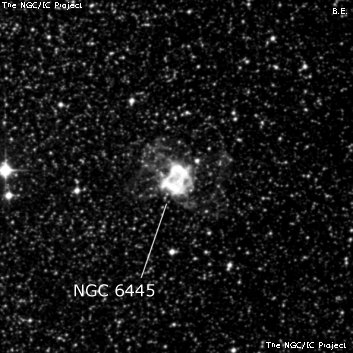NGC/IC Project Restoration Effort
(This is a very very beta version)
NGC6445


Basic Information
Location and Magnitude
Right Ascension: 17:49:15.1
Declination: -20:0:32
Constellation: SGR
Visual Magnitude: 11.2
Historic Information
Discoverer: Herschel W.
Year of discovery: 1786
Discovery aperture: 18.7
Observational
Summary description: pB, pS, R, gbM, r, * 15 np
Sub-type: PN
Steve's Notes
=====
NGC 6445
24" (8/14/15): this highly structured planetary was observed using 500x. NGC 6445 has an unusual rectangular shape, elongated 3:2 NW-SE, with dimensions ~45"x30". The planetary is brighter in fairly narrow strips along the four sides, creating an annular appearance. The short northwest facing side is slightly brighter and contains a bright knot or section near the middle. In addition, a faint knot is at the north vertex. Another bright knot is at the east vertex and either a faint knot or very faint star is at the south vertex. The short southeast facing side is sharply defined and quite straight. A very low surface brightness glow can be seen outside (east) of the eastern vertex. In addition, with careful viewing an extremely faint outer shell or loop is outside the long southwest facing side, connected at the two vertices along this side. A mag ~15.5 star is just outside the midpoint of the loop. The outer shell or loop on the northeast side was not seen.
18" (7/22/06): this fascinating planetary was viewed at 435x. The overall shape is rectangular with the longer sides oriented NW to SE. Both ends are noticeably brighter giving an annular appearance. The NW end is slightly brighter and irregular in surface brightness with a brighter spot or two. The rim at the northwest end is slightly bowed out and has a well-defined boundary edge in the interior. The rim at the southeast end of the planetary is unusually straight and well-defined. With averted vision it appeared to extend slightly beyond the main body of the planetary. The bright lobe at this end is bar-shaped and extended SW to NE in the direction of the minor axis.
17.5" (7/14/99): this bright PN is striking at 280x with a great deal of structure evident. It has a boxy appearance, elongated NW-SE with dimensions ~45"x30". The ends of the major axis are clearly brighter with a bright, shallow arc or crescent-shaped curve on the NW end. This lobe has an irregular surface brightness with a couple of brighter spots. The SE lobe is brighter but has an oddly flat edge. At 380x, the eastern end of the southeast lobe is brighter and has a small extension or nodule that bulges out beyond the rectangular outline to the east. The center is clearly darker and with careful viewing appears as a dark band running SW-NE. A mag 12 star lies ~45" NW of center and the planetary precedes a wide uneven mag 8/10.5 pair by 5'. The planetary forms an unusual pair with GC NGC 6440 20' SSW.
13" (8/5/83): bright, fairly small, elongated NW-SE, brighter along the NW side. A darker center visible at 288x appears to cut through the minor axis. The NW edge is slightly curved while the other sides and corners are "boxy" giving an irregular rectangular outline. The ends of the minor axis are fainter. A wide double star h2810 = 7.7/10.5 at 41" lies 5.3' E. A mag 12 star is just off the NW end about 40" from the center. Forms a striking pair with globular cluster NGC 6440 20' SSW in the same low power field.
13.1" (7/16/82): dark center at 280x appears to bisect the planetary ~E-W.
8" (6/27/81): fairly bright, elongated, uniform. Located within string of four mag 11/12 stars.



